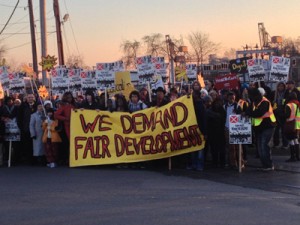
By Will Fadely, Baltimore Organizer
Energy Answers a dirty Waste-to-Energy Incinerator is being constructed less than 1 Mile from Schools, Parks, Playgrounds, Homes, and Water Bodies of the community of Curtis Bay.
Waste-to-Energy (WTE) may sound “green”, but residents of Curtis Bay know that this is nothing but a euphemism for a trash burning incinerator with all its toxic pollution and health hazards.
Energy Answers plans to build a new incinerator in Baltimore which leads the nation in air pollution related deaths per capita. A recent report found that, “WTE incinerators in Maryland emit more pollutants per hour of energy produced than Maryland’s largest coal-fired power plants.” These pollutants include toxins like mercury and lead, which even in small doses significantly harm children and bioaccumulate over time.
That’s why we marched.
On December 18, 2013, Clean Water Action, students from Benjamin Franklin High United Workers, Free Your Voice, Unite Here Local 7, Environment Maryland, public health advocates, religious leaders, and residents marched from Benjamin Franklin high school to the proposed Energy Answers WTE Incinerator site, less than one mile away. “Let’s show them [Energy Answers, Governor O’Malley and Mayor Rawlings-Blake] that we’re not going to take it,” exclaimed Destiny Watford, 18, “Curtis Bay is not a dumping ground!” Watford is an alumna of Benjamin Franklin high school and now attends Towson University.
Unfortunately for Destiny and every other student and family in Curtis Bay, the Maryland Public Service Commission, Governor O’Malley, and Mayor Rawlings Blake are acting as if their community is a public dumping site. Despite the 13.6 million pounds of toxic air releases in 2009, all three governing bodies have given their support for the incinerator and even fast tracked the Certification of Public Convenience and Necessity (CPCN), which grants approval for building a large industrial facility.
Dozens of protesters stomped and shouted as they marched the short mile to the proposed incinerator site. Demanding for “Fair Development,” community members took to the streets. And boy did their voices echo.
As the protesters reached the incinerator site, each one tied a flower to the fence surrounding the construction site. “Flowers are green,” chanted protesters, “Incinerators are not!”
The referenced media source is missing and needs to be re-embedded.
The march to the incinerator
The referenced media source is missing and needs to be re-embedded.
Protesters finished their march, being led in prayer by local religious leaders asking that the community be protected from this and further dangerous development.
While we’ve been telling people in Baltimore City about the trash incinerator, Free Your Voice, a student group has been canvassing the Curtis Bay community educating fellow residents about the potential harmful effects Curtis Bay would suffer if Energy Answers constructs its incinerator. As part of their campaign, they have also made a photo-petition, filmed several videos and written letters to public officials. You can view the photo petition, videos and send a letter to Governor O’Malley and Mayor Stephanie Rawlings Blake showing your opposition to the construction of Energy Answers’ incinerator here.
The referenced media source is missing and needs to be re-embedded.
Isn’t Waste-to-Energy Green?
Not in the slightest. If built, this particular incinerator will burn 4,000 tons of trash each day completely made up of old tires, car parts, and wood waste. Burning these three types of waste will emit 240 lbs. of mercury per year. This is more pollution than any coal plant in the United States.
This table from the Environmental Integrity Report shows the cost is not worth the benefit. Comparatively, Energy Answers would produce 2.5 times more electric capacity than MCRRF incinerator and current incinerator Wheelabrator Baltimore City incinerator, yet would emit 3.5x more Lead (lbs) than Wheelabrator Baltimore City incinerator and nearly 8x more Lead (lbs) than MCRRF incinerator. Even coal fired power plants pollute less lead and mercury than a “green” WTE incinerator.
The referenced media source is missing and needs to be re-embedded.
In 2009, Maryland was just shy of its 57% MSW landfill capacity level, with room for over 60 million tons of trash beyond 2030. As we continue down this path, Maryland has the ability to incinerate 32% of waste generated in the state.
At the beginning of the rally Destiny exclaimed “Curtis Bay is not a dumping ground.” Given this data, if it already isn’t a dumping ground, it’s set to become the unofficial East Coast dump if the Energy Answers Waste-to-Energy Incinerator is built.
The referenced media source is missing and needs to be re-embedded.
Related Posts
Stay Informed
Get the latest updates and actions:
Thanks for signing up!
There was a problem processing your signup. Please try again.


